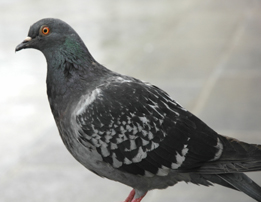Feral pigeons - management and control
 Feral pigeons can be public health pests. They can accumulate wherever there is food and shelter, and can take up residence almost anywhere, including around houses, tall city buildings or schools. As well as being a nuisance and causing extensive damage to property, feral pigeons can also pose a risk to human health.
Feral pigeons can be public health pests. They can accumulate wherever there is food and shelter, and can take up residence almost anywhere, including around houses, tall city buildings or schools. As well as being a nuisance and causing extensive damage to property, feral pigeons can also pose a risk to human health.
Feral pigeons are common in the urban environment and although they are generally considered to be no more than a nuisance, they can potentially pose a risk to human health. Pigeons and their droppings can also cause damage to the buildings they reside, perch or nest in or on.
Potential health risks
Potential health risks and examples of damage include:
- Transmission of diseases such as histoplasmosis, cryptococcosis, and psittacosis (ornithosis).
- Attraction of ticks, mites, cockroaches and rats.
- Unpleasant odour and noise issues.
- Damage to buildings and monuments due to the highly corrosive nature of pigeon droppings.
- Extensive damage to air-conditioning units and other roof top machinery.
About pigeons
Feral pigeons are descendants of domestic homing pigeons that were introduced to Australia from Europe. Increased urban development has resulted in an increase in the number of feral pigeons due to the large number of accessible nesting spaces and readily available supply of food and water. Pigeons are capable of breeding throughout the year and do not migrate far from their birthplace; this can make it difficult to remove them from their location.
It is important that other members of the community also adopt pigeon control techniques, otherwise the pigeons may simply relocate to a neighbouring property and the flock size will not be reduced.
Identifying feral pigeons
Feral pigeons can be grey, brown, or white, but are usually grey with two black bars across each wing and iridescent feathers around the neck. There are no visible differences between males and females.
Domestic pigeons, such as those kept as pets or for racing, are essentially the same birds as feral pigeons; however, domestic pigeons can be identified by the presence of a tag around one of their legs.
Non-lethal control techniques
If you have a pigeon problem, there are many techniques that can be used to reduce or remove the population. Implementing non-lethal control techniques will provide the most effective long term results. The best way to minimise or prevent the nuisance caused by feral pigeons is to control where they roost, nest and feed.
Removing food sources
The most effective way of discouraging feral pigeons from infesting houses and public areas is to not feed them and remove any potential food source (for example pet food). The number of pigeons in an area is determined by the availability of a sustainable food supply. A plentiful food supply encourages year round breeding; therefore, the removal of the food source will result in less breeding and will also encourage the pigeons to move to another location.
Proofing
Pigeon proofing your building will prevent pigeons from gaining access to potential nesting or roosting sites. This includes sealing any gaps into buildings and under eaves with mesh or wooden panels, or with more extensive renovations. Pigeons commonly perch on sites such as eaves, roofs and window ledges. A licensed pest control operator can install products such as mesh, wires, spikes and gel in these locations to prevent pigeons from landing.
Nest removal
Regular removal of nests will, in the long term, help to discourage persistent pigeons from nesting in a particular area.
Scare devices
Scare devices such as audio or visual deterrents can discourage pigeons from roosting or nesting.
Lethal control techniques
Lethal control techniques can be used to reduce pigeon numbers. However, this is usually only a short term solution as removed pigeons are quickly replaced by juvenile birds and the flock can become larger than the initial size. With any lethal control method, animal welfare issues need to be considered and addressed.
Trapping
Pigeons caught and killed by trapping can be replaced by new populations rapidly. As with any control technique, the source of food must be removed otherwise trapping may have minimal success in reducing pigeon numbers.
Shooting
A person with a suitable gun licence will assess each situation and determine if shooting is a suitable option.
Sedation
This process must be carried out by licensed pest control operators only. A painless narcotic (alpha-chloralose) is added to the food source and, once consumed, it will induce first a state of dissociation, then sleep. All the essential bodily functions are unaffected; the bird is merely stupefied and sedated birds can then be easily collected for euthanasia. Free feeding of birds as required by the product label should minimise the possibility of ingestion by non-target species. However, non-target species can be picked up and revived by placing them in a darkened enclosure at normal temperature. When baiting has finished affected birds should be collected immediately and the area should be swept, and the bait should be disposed of or re-used.
Protecting yourself
When dealing with pigeons and/or pigeon droppings it is important to ensure that you are properly protected.
The following personal protective equipment should be worn:
- protective clothing
- gloves
- goggles
- face mask/respirator
Further information
For advice on feral pigeon control, contact an Environmental Health Officer at your local council.